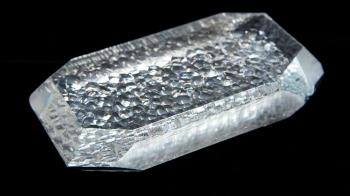The quartz crystal oscillator used in quartz watches has just celebrated its 50th anniversary. Miniaturised by a team of researchers at the Centre Electronique Horloger in Neuchâtel, this technology is now at a turning point in its history. One the one hand, it has reached an exceptional level of performance and maturity – to the point that it’s legitimate to wonder how much more improvement is possible. But on the other, it’s threatened by the advent of wrist-mounted super-computers that take their time data from remote servers, rather than calculating it natively.
A quartz watch costs practically nothing. Even from a well-known brand, the entry price for an analogue watch is around CHF 20. It’s even possible to pick up discounted models for less than one franc on Amazon. A quartz movement costs practically nothing, too. Online, a good quality quartz movement retails for around ten francs. A quartz movement requires virtually no energy. A 90 mAh battery, which costs 80 centimes, will last 3 to 5 years. A quartz movement can be wound by wrist action, a battery, an accumulator or solar energy. It can switch to standby mode without losing track of the elapsed time. It can even drive a perpetual calendar, a minute repeater, an alarm, and 50 different timers. And for this negligible sum, it tells the time with supreme accuracy, losing no more than a couple of minutes a year.
It’s cheap, reliable, stable, with no moving parts and no lubrication; it’s unaffected by magnetism or gravity, resistant to temperature fluctuation thanks to temperature compensation mechanisms, and easily mass-produced. It was the ultimate dream of progress in watchmaking... before it became a nightmare. In the 1980s, the logic of economies of scale, industrial investment and cheap labour pushed Swiss watchmaking into a rut, and Japanese manufacturers swiftly forged ahead, followed by the Chinese. Despite the high-end models produced by Girard-Perregaux and F.P. Journe, high-precision efforts at Longines, and the multifunctional timepieces made by Tissot and its Japanese competitors, quartz has no place at watchmaking’s high table. The problem is that it now risks being hounded out of the entry-level sector too.

And yet, analogue watches have stood the test of time. Digital watches, which are easier to read, easier to light, easier to make and more accurate than watches with hands, did not take over the world after all. Which proves that time has a special place in our hearts, and that we still like to read it in the traditional – perhaps even archaic – manner. The sun dial and its gnomon, ancestors of the hand, are imprinted on our reptilian brains.
For the same price as a metal analogue quartz watch such as those produced by dozens of Swiss brands, today’s clients can choose to buy a smartwatch. Inside is a processor, an accumulator, a network card and a controller for the screen and/or buttons. But – thanks to the calculation and connection abilities of the smartwatch – no quartz oscillator to provide the time. Nevertheless, quartz has reached such a pitch of perfection that no major leaps in quality can be expected. And even if they could, most people wouldn’t be able to see the difference. More precise than one second per year? An autonomy of 6 years rather than 5?
When Swatch Group complains that its movement suppliers are still struggling, we should take notice. When exports of Swiss watches priced at less than 200 francs have fallen steadily since 2015, and continue to fall, despite the fact that the industry is picking up, that might provide an explanation. Will quartz, the watches it drives and the brands that sell them be obliged to rethink their approach?









